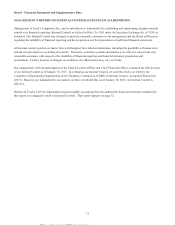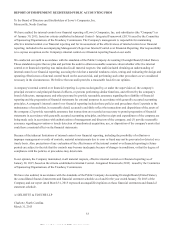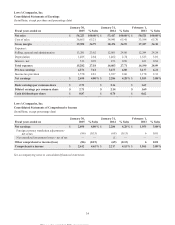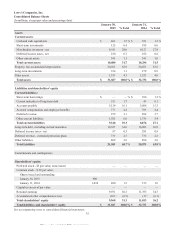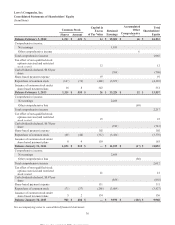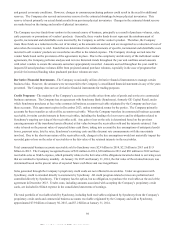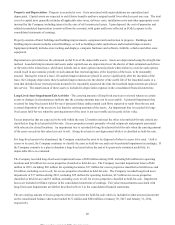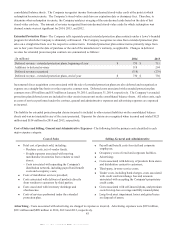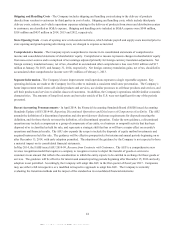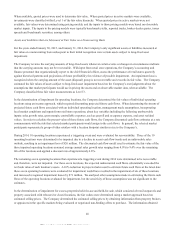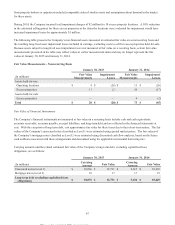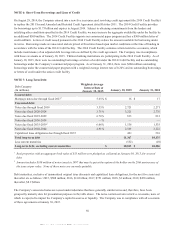Lowe's 2014 Annual Report Download - page 51
Download and view the complete annual report
Please find page 51 of the 2014 Lowe's annual report below. You can navigate through the pages in the report by either clicking on the pages listed below, or by using the keyword search tool below to find specific information within the annual report.When locations under operating leases are closed, a liability is recognized for the fair value of future contractual obligations,
including future minimum lease payments, property taxes, utilities, common area maintenance and other ongoing expenses, net
of estimated sublease income and other recoverable items. When the Company commits to an exit plan and communicates that
plan to affected employees, a liability is recognized in connection with one-time employee termination benefits. Subsequent
changes to the liabilities, including a change resulting from a revision to either the timing or the amount of estimated cash
flows, are recognized in the period of change. Expenses associated with exit activities are included in SG&A expense in the
consolidated statement of earnings.
Equity Method Investments - The Company’s investments in certain unconsolidated entities are accounted for under the
equity method. The balance of these investments is included in other assets (noncurrent) in the accompanying consolidated
balance sheets. The balance is increased to reflect the Company’s capital contributions and equity in earnings of the
investees. The balance is decreased to reflect its equity in losses of the investees and for distributions received that are not in
excess of the carrying amount of the investments. Equity in earnings and losses of the investees has been immaterial and is
included in SG&A expense.
Leases - For lease agreements that provide for escalating rent payments or free-rent occupancy periods, the Company
recognizes rent expense on a straight-line basis over the non-cancellable lease term and option renewal periods where failure to
exercise such options would result in an economic penalty in such amount that renewal appears, at the inception of the lease, to
be reasonably assured. The lease term commences on the date that the Company takes possession of or controls the physical
use of the property. Deferred rent is included in other liabilities (noncurrent) on the consolidated balance sheets.
When the Company renegotiates and amends a lease to extend the non-cancellable lease term prior to the date at which it would
have been required to exercise or decline a term extension option, the amendment is treated as a new lease. The new lease
begins on the date the lease amendment is entered into and ends on the last date of the non-cancellable lease term, as adjusted
to include any option renewal periods where failure to exercise such options would result in an economic penalty in such
amount that renewal appears, at the inception of the lease amendment, to be reasonably assured. The new lease is classified as
operating or capital under the authoritative guidance through use of assumptions regarding residual value, economic life,
incremental borrowing rate, and fair value of the leased asset(s) as of the date of the amendment.
Accounts Payable - The Company has an agreement with a third party to provide an accounts payable tracking system which
facilitates participating suppliers’ ability to finance payment obligations from the Company with designated third-party
financial institutions. Participating suppliers may, at their sole discretion, make offers to finance one or more payment
obligations of the Company prior to their scheduled due dates at a discounted price to participating financial institutions. The
Company’s goal in entering into this arrangement is to capture overall supply chain savings, in the form of pricing, payment
terms or vendor funding, created by facilitating suppliers’ ability to finance payment obligations at more favorable discount
rates, while providing them with greater working capital flexibility.
The Company’s obligations to its suppliers, including amounts due and scheduled payment dates, are not impacted by
suppliers’ decisions to finance amounts under this arrangement. However, the Company’s right to offset balances due from
suppliers against payment obligations is restricted by this arrangement for those payment obligations that have been financed
by suppliers. As of January 30, 2015, and January 31, 2014, $1 billion and $735 million, respectively, of the Company’s
outstanding payment obligations had been placed on the accounts payable tracking system, and participating suppliers had
financed $724 million and $443 million, respectively, of those payment obligations to participating financial institutions.
Other Current Liabilities - Other current liabilities on the consolidated balance sheets consist of:
41
This proof is printed at 96% of original size
This line represents final trim and will not print


